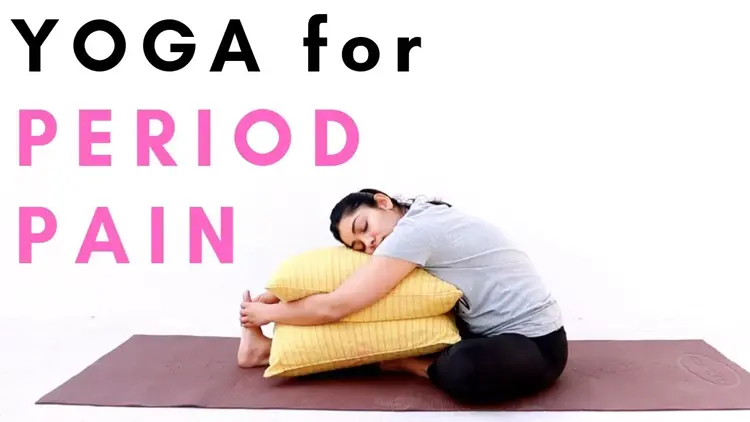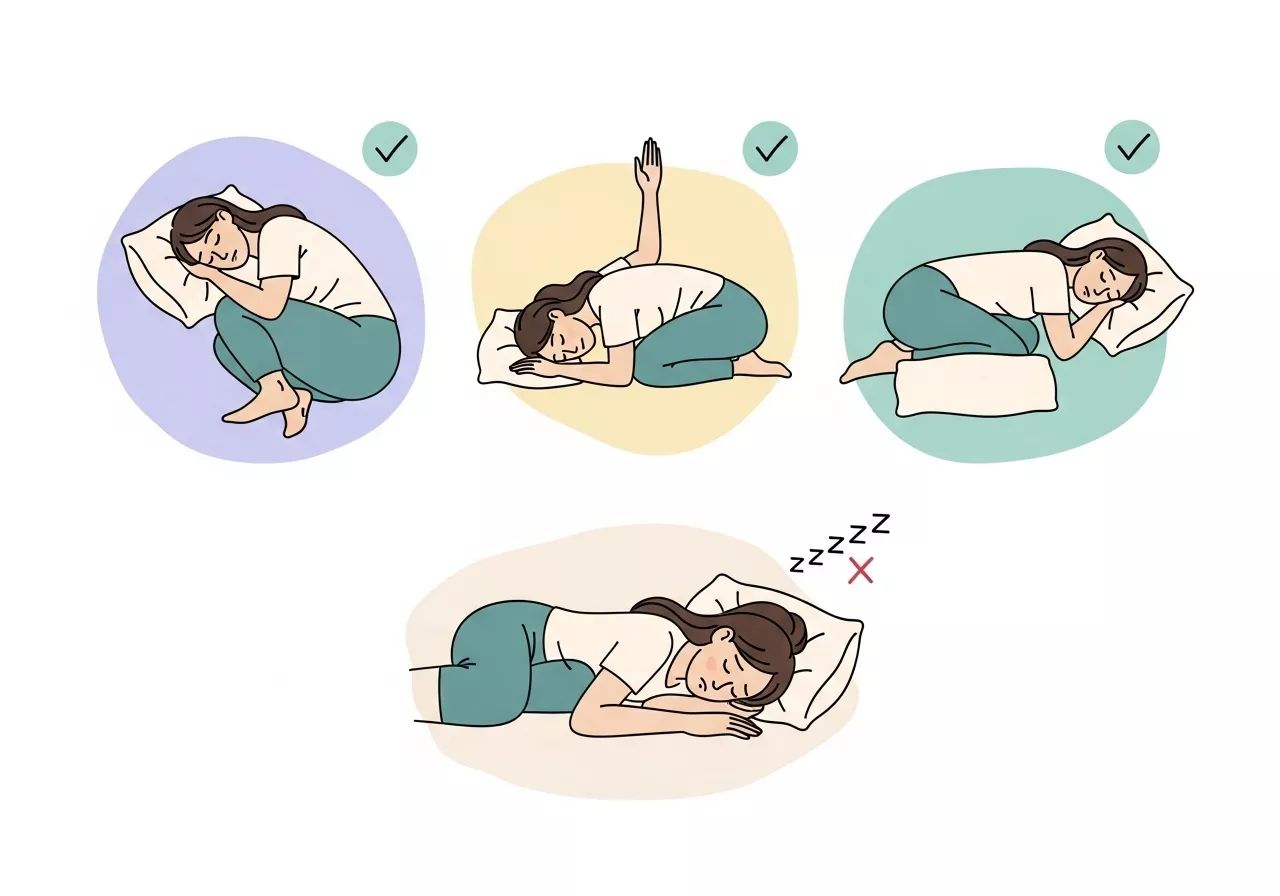Menstrual pain is a common experience for many individuals, often accompanied by cramps, fatigue, headaches, and mood swings.
Yoga is a natural and effective way to alleviate these symptoms by promoting relaxation, improving circulation, and calming the nervous system.

Below is a detailed guide to seven yoga poses that can help ease menstrual discomfort.
1. Bound Angle Pose (Baddha Konasana)
This pose, also known as the Butterfly Pose, gently stretches the inner thighs and hips, stimulating the reproductive organs and relieving menstrual cramps.

How to Do It:
- Sit on the floor with your back straight and legs extended.
- Bend your knees and bring the soles of your feet together, allowing your knees to drop to the sides.
- Hold your feet with your hands and sit tall, elongating your spine.
- Hold for 1–2 minutes, focusing on deep breaths.
Benefits:
- Relieves menstrual cramps and lower back pain.
- Improves blood flow to the pelvis and reproductive organs.
- Helps calm the mind and reduce stress.
Modification:
- Place cushions under your knees if they don’t touch the floor for added support.
2. Reclined Bound Angle Pose (Supta Baddha Konasana)
This restorative pose is excellent for relieving abdominal discomfort and calming the mind.

How to Do It:
- Lie on your back with your knees bent and feet flat on the floor.
- Bring the soles of your feet together and let your knees fall open to the sides.
- Place pillows or blocks under your knees for support.
- Rest your arms by your sides, palms facing up, and close your eyes.
- Stay in this position for 3–5 minutes, breathing deeply.
Benefits:
- Relaxes the abdominal muscles and reduces cramps.
- Eases symptoms like fatigue, anxiety, and insomnia.
- Encourages mindfulness and relaxation.
Modification:
- If lying flat is uncomfortable, place a bolster under your back for gentle elevation.
3. Child’s Pose (Balasana)
A comforting and grounding pose, Child’s Pose gently stretches the lower back and hips, relieving tension in the body.

How to Do It:
- Start on your hands and knees in a tabletop position.
- Bring your big toes together and spread your knees wide apart.
- Sit back onto your heels and stretch your arms forward, resting your forehead on the mat.
- Hold the pose for 1–2 minutes, breathing slowly and deeply.
Benefits:
- Relieves tension in the back, shoulders, and neck.
- Provides gentle compression to the abdomen, alleviating cramps.
- Calms the nervous system and reduces stress.
Modification:
- Place a cushion under your hips if sitting on your heels is uncomfortable.
4. Wide-Angle Seated Forward Bend (Upavistha Konasana)
This pose gently stretches the hips, lower back, and hamstrings while stimulating the abdominal organs.

How to Do It:
- Sit on the floor with your legs extended wide apart.
- Flex your feet and sit tall, lengthening your spine.
- Slowly walk your hands forward, lowering your torso as far as comfortable.
- Hold the pose for 1–2 minutes, breathing deeply.
Benefits:
- Reduces the intensity of menstrual cramps.
- Stretches the lower back and hamstrings.
- Promotes relaxation and mental clarity.
Modification:
- Sit on a folded blanket to elevate your hips if your hamstrings feel tight.
5. Reclining Twist (Bharadvaja’s Twist)
This gentle twist soothes the lower back and massages the abdominal organs, relieving tension and pain.

How to Do It:
- Lie on your back with your legs extended.
- Bend your right knee and bring it across your body to the left, allowing it to rest on the floor or a cushion.
- Stretch your arms out to the sides and turn your head to the right.
- Hold for 1–2 minutes, then switch sides.
Benefits:
- Relieves lower back pain and menstrual cramps.
- Stimulates digestion and reduces bloating.
- Promotes relaxation and stress relief.
Modification:
- Place a pillow under your bent knee for added support.
6. Legs-Up-the-Wall Pose (Viparita Karani)
This restorative pose is excellent for reducing lower back pain, improving circulation, and calming the mind.

How to Do It:
- Sit sideways next to a wall and swing your legs up as you lower your back onto the floor.
- Adjust your position so that your hips are close to the wall and your legs rest vertically.
- Rest your arms by your sides and close your eyes.
- Stay in the pose for 5–10 minutes, breathing deeply.
Benefits:
- Relieves tension in the lower back and pelvis.
- Enhances blood flow and reduces swelling in the legs.
- Calms the nervous system and promotes deep relaxation.
Modification:
- Place a folded blanket or bolster under your hips for extra support.
7. Head-to-Knee Forward Bend (Janu Sirsasana)
This pose provides a deep stretch to the hamstrings and spine while supporting the reproductive and digestive systems.

How to Do It:
- Sit on the floor with your legs extended.
- Bend your right knee and bring the sole of your foot to your inner left thigh.
- Inhale and reach your arms overhead, then exhale as you fold forward over your extended leg.
- Hold for 1–2 minutes, then switch sides.
Benefits:
- Relieves anxiety, fatigue, and menstrual cramps.
- Stretches the hamstrings and lower back.
- Promotes relaxation and mental clarity.
Modification:
- Use a strap around your extended foot if you cannot reach it comfortably.
Tips for Practicing Yoga During Menstruation

- Listen to Your Body: Avoid poses that feel uncomfortable or cause strain.
- Focus on Relaxation: Choose gentle, restorative poses rather than intense or vigorous sequences.
- Use Props: Cushions, blankets, and straps can enhance comfort and support.
- Breathe Deeply: Incorporate slow, steady breathing to relax your mind and body.
Practicing these seven yoga poses during your menstrual cycle can provide significant relief from cramps, fatigue, and stress.
Each pose is designed to gently stretch, relax, and restore your body, promoting a sense of ease and balance.
Remember, the key is to move mindfully, listen to your body, and prioritize comfort.
With regular practice, yoga can become a powerful tool for managing menstrual discomfort naturally.
Should I Workout on My Period?
Exercising during your period can be a topic of debate, with many wondering whether it’s beneficial or harmful.
The truth is, staying active during your menstrual cycle has numerous benefits, but it’s essential to approach it mindfully.
Here’s a detailed guide to help you understand how exercise impacts your body during menstruation, the benefits and challenges, and how to adapt your workouts.
Benefits of Working Out During Your Period

1. Relieves Menstrual Cramps:
- Light to moderate exercise increases blood circulation, which can help alleviate cramps by relaxing the uterine muscles.
- Endorphins, the body’s natural painkillers released during exercise, also help reduce pain and improve mood.
2. Boosts Energy Levels:
- Hormonal fluctuations during your period can make you feel fatigued. Low-intensity workouts like yoga or walking can boost energy without overwhelming your body.
3. Improves Mood:
- Menstruation can bring mood swings, irritability, and anxiety. Exercise triggers the release of serotonin and dopamine, the “feel-good” hormones, which can help stabilize your mood.
4. Reduces Bloating:
- Physical activity helps with digestion and reduces water retention, alleviating the bloating often associated with menstruation.
5. Supports Regular Cycles:
- Regular exercise may contribute to a more consistent menstrual cycle and reduce the severity of symptoms over time.
Challenges of Working Out During Your Period
1. Low Energy Levels:
- Fatigue is common during menstruation, especially on heavier flow days. Overexertion can leave you feeling drained.
2. Increased Discomfort:
- High-impact exercises or intense workouts may exacerbate cramps or make you feel uncomfortable, particularly if you’re experiencing heavy bleeding.
3. Body Temperature Sensitivity:
- Hormonal changes can affect body temperature regulation, making you feel hotter or more tired during workouts.
4. Risk of Dehydration:
- Blood loss can lead to a slight drop in hydration levels. Without adequate water intake, you might feel fatigued or dizzy during exercise.
Workouts to Avoid During Your Period
1. High-Intensity Interval Training (HIIT):
- Intense workouts may be too taxing on days when you’re feeling fatigued or experiencing heavy bleeding.
2. Long-Duration Endurance Activities:
- Running marathons or extended sessions of intense exercise may deplete your energy and exacerbate symptoms.
3. Inversions:
- Poses that position your pelvis above your heart (e.g., Headstands or Shoulder Stands) may not feel comfortable during heavy flow days.
Tips for Exercising on Your Period
1. Listen to Your Body:
- If you feel tired or uncomfortable, prioritize rest over pushing through a workout. It’s okay to skip exercise if your body needs recovery.
2. Stay Hydrated:
- Drink plenty of water to prevent dehydration and combat fatigue.
3. Wear Comfortable Clothing:
- Choose breathable, stretchy fabrics and consider darker colors to feel more confident.
4. Use Appropriate Menstrual Products:
- Tampons, menstrual cups, or period-proof underwear are great options to stay comfortable during workouts.
5. Warm-Up and Cool Down:
- Gentle stretching before and after exercise can reduce soreness and improve circulation.
6. Eat Wisely:
- Fuel your body with nutrient-dense snacks before working out to maintain energy levels.
When to Avoid Exercise During Your Period
While exercise is generally beneficial, there are times when it’s better to rest:
- Severe Pain: If cramps are debilitating, prioritize relaxation techniques and gentle stretching.
- Heavy Bleeding: If you’re experiencing unusually heavy flow or feeling dizzy, opt for light activity or rest.
- Underlying Medical Conditions: Conditions like endometriosis or anemia may require special considerations during exercise. Consult your healthcare provider for guidance.
Working out on your period is a personal decision that depends on how your body feels.
For many, light to moderate exercise offers significant benefits, such as pain relief, improved mood, and increased energy levels.
However, it’s important to listen to your body, adapt your routine as needed, and focus on exercises that make you feel comfortable and empowered.
Remember, rest is just as important as movement, so give yourself grace during this time.



